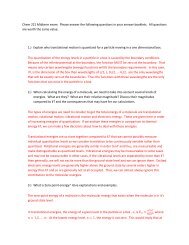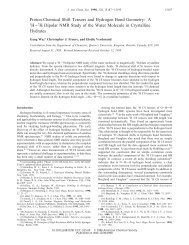CURRICULUM VITAE Dr. Erwin Buncel - Department of Chemistry ...
CURRICULUM VITAE Dr. Erwin Buncel - Department of Chemistry ...
CURRICULUM VITAE Dr. Erwin Buncel - Department of Chemistry ...
You also want an ePaper? Increase the reach of your titles
YUMPU automatically turns print PDFs into web optimized ePapers that Google loves.
<strong>CURRICULUM</strong> <strong>VITAE</strong><br />
<strong>Dr</strong>. <strong>Erwin</strong> <strong>Buncel</strong><br />
Affiliation and <strong>of</strong>ficial address: Queen's University, <strong>Department</strong> <strong>of</strong> <strong>Chemistry</strong><br />
Kingston, Ontario, CANADA K7L 3N6<br />
EDUCATION (degrees, dates, universities)<br />
- B.Sc., <strong>Chemistry</strong>, 1st class Honours, University <strong>of</strong> London, England, 1954<br />
- Ph.D., Organic <strong>Chemistry</strong>, University <strong>of</strong> London, 1957<br />
- D.Sc., Physical Organic <strong>Chemistry</strong>, University <strong>of</strong> London, 1970<br />
ACADEMIC, RESEARCH AND INDUSTRIAL EXPERIENCE<br />
Positions Held Dates <strong>Department</strong> Institution<br />
Pr<strong>of</strong>essor Emeritus 1996 <strong>Chemistry</strong> Queen’s University<br />
Visiting Pr<strong>of</strong>essor 1996,1999 <strong>Chemistry</strong> University <strong>of</strong> Versailles<br />
Visiting Pr<strong>of</strong>essor 1994 (Spring) <strong>Chemistry</strong> Korea University<br />
Visiting Pr<strong>of</strong>essor 1989 (Sept-Dec) <strong>Chemistry</strong> University <strong>of</strong> Paris<br />
Visiting Scientist 1987 (June-July) <strong>Chemistry</strong> University <strong>of</strong> Warsaw<br />
Visiting Pr<strong>of</strong>essor 1987 (Spring) <strong>Chemistry</strong> Univ. <strong>of</strong> Surrey (U.K.)<br />
Visiting Pr<strong>of</strong>essor 1982 (June-July) <strong>Chemistry</strong> University <strong>of</strong> Paris<br />
Pr<strong>of</strong>essor 1970 <strong>Chemistry</strong> Queen's University<br />
Associate Pr<strong>of</strong>essor 1966-1970 <strong>Chemistry</strong> Queen's University<br />
Assistant Pr<strong>of</strong>essor 1962-1966 <strong>Chemistry</strong> Queen's University<br />
Research Chemist 1960-1962 Central Research American Cyanamid<br />
NRC Fellow 1958-1960 <strong>Chemistry</strong> McMaster University<br />
Postdoctoral Fellow 1957-1958 <strong>Chemistry</strong> Univ. <strong>of</strong> N. Carolina<br />
MEMBERSHIP OF PROFESSIONAL SOCIETIES<br />
Canadian Chemical Society, Past Chairman <strong>of</strong> Organic Division, Chemical Institute <strong>of</strong> Canada,<br />
American Chemical Society, Royal Society <strong>of</strong> <strong>Chemistry</strong>, International Group for Correlation Analysis<br />
in Organic <strong>Chemistry</strong>, International Isotope Society (First President <strong>of</strong> Canadian Chapter).<br />
HONOURS/AWARDS<br />
Syntex Award in Physical Organic <strong>Chemistry</strong> (1985 - Chemical Institute <strong>of</strong> Canada, for<br />
distinguished research accomplishments in physical organic chemistry)<br />
Fellow, Chemical Institute <strong>of</strong> Canada<br />
Member <strong>of</strong> International Committee to evaluate research in physical organic chemistry in Swedish<br />
Universities for Swedish Natural Sciences Research Council, and <strong>of</strong> Berkeley National Tritium Lab.<br />
Trustee, International Isotope Society<br />
Canadian representative on IUPAC (International Union <strong>of</strong> Pure & Applied <strong>Chemistry</strong>) Committee for<br />
CHEMRAWN - Chemical Research Applied to World Needs (1993- )<br />
1996 Ontario-Quebec Physical Organic Minisymposium dedicated to <strong>Buncel</strong><br />
Special Issue <strong>of</strong> Canadian Journal <strong>of</strong> <strong>Chemistry</strong> dedicated to <strong>Buncel</strong> (1998).<br />
R.U. Lemieux Award in Organic <strong>Chemistry</strong> - Canadian Society for <strong>Chemistry</strong> (1999).<br />
Fellow, World Innovation Foundation (2001).<br />
2
GRADUATE STUDENTS AND POST-DOCTORAL FELLOWS<br />
Successfully Completed In Progress<br />
A. Doctoral theses 35 3<br />
B. Master's theses 31 3<br />
C. Post-doctoral fellows 52 2<br />
PUBLICATIONS<br />
Number <strong>of</strong> papers in refereed journals published or in press 302; Books 4; Chapters<br />
10; Reviews 10; Edited monographs 15; Popular articles 5; Conference proceedings<br />
20; presentations 210.<br />
EDITORIAL ACTIVITIES:<br />
Editor (Physical Organic <strong>Chemistry</strong>), Canadian Journal <strong>of</strong> <strong>Chemistry</strong> (1981-1993)<br />
Editor, Journal <strong>of</strong> Labelled Compounds and Radiopharmaceuticals (1995-)<br />
Advisory Board: Journal <strong>of</strong> Physical Organic <strong>Chemistry</strong>; U.K. Royal Society <strong>of</strong><br />
<strong>Chemistry</strong>, <strong>Chemistry</strong> International.<br />
Co-editor <strong>of</strong> monographs:<br />
Comprehensive Carbanion <strong>Chemistry</strong>.<br />
Isotopes in Organic <strong>Chemistry</strong>;<br />
Isotopes in the Physical and Biomedical Sciences;<br />
INVITED/PLENARY SPEAKER AT MAJOR CONFERENCES<br />
Over the past 10 years <strong>Buncel</strong> has been invited/plenary speaker at 20 major conferences,<br />
including the 1st Latin-American Conference on Physical Organic <strong>Chemistry</strong>, Florionopolis,<br />
Brazil (Plenary Lecturer), 1991; the 5th Conference on Correlation Analysis in <strong>Chemistry</strong>,<br />
Paris (Invited Speaker), 1992; 4th International Symposium on Synthesis and Applications<br />
<strong>of</strong> Isotopes and Isotopically Labelled Compounds, Toronto (Invited Speaker), 1991; 77th<br />
Chemical Institute <strong>of</strong> Canada Conference, Winnipeg (Invited Speaker), 1994; 6th<br />
Conference on Correlation Analysis in <strong>Chemistry</strong>, Prague (Plenary Lecturer), 1994;<br />
International Conference on Electron Transfer Processes (Krakow, 1997, Declined); 8th<br />
International Conference on Correlation Analysis in <strong>Chemistry</strong>, India (Plenary Lecturer),<br />
1999; 82nd Canadian Society for <strong>Chemistry</strong>, R.U. Lemieux Award Lecture (1999).<br />
Materials <strong>Chemistry</strong> Canada Colloquium, Victoria (2002).<br />
INVITED LECTURES<br />
70 research seminars presented at university and other research institutions in Canada,<br />
United States, England, Scotland, Ireland, France, Italy, Spain, Germany, Poland, Czech<br />
Republic, Israel, Brazil, Korea, Nigeria, and India.<br />
ORGANIZATION OF SYMPOSIA/CONFERENCES<br />
<strong>Buncel</strong> has organized 18 symposia, beginning in 1969 with the Symposium on Molecular<br />
Rearrangements (52nd CIC Conference, Montreal), through to 1994 with Experimental<br />
and theoretical approaches to transition states in organic chemistry (77th CIC Conference,<br />
Winnipeg), and 1996 with Symposium on isotopes in drug discovery, nuclear medicine,<br />
3
nutrition, agriculture and protection (4th Meeting <strong>of</strong> Canadian Chapter <strong>of</strong> International<br />
Isotope Society, Toronto), including three Physical Organic Minisymposia at Queen’s. He<br />
was Co-Chair <strong>of</strong> the 4th International Symposium on Synthesis and Applications <strong>of</strong><br />
Isotopes and Isotopically Labelled Compounds, Toronto, 1991. He served on the<br />
International Advisory Board <strong>of</strong> the 8th International Conference on Correlation Analysis in<br />
<strong>Chemistry</strong> (India, 1999).<br />
INTERNATIONAL ACTIVITIES<br />
International Union <strong>of</strong> Pure and Applied <strong>Chemistry</strong> (IUPAC) activities<br />
Member <strong>of</strong> International Organizing Committee and Conference Editor for 5th<br />
International Conference on Physical Organic <strong>Chemistry</strong>, Santa Cruz, 1980.<br />
Member <strong>of</strong> committees on symbolization and naming <strong>of</strong> organic reaction<br />
mechanisms.<br />
Contributor to Glossary <strong>of</strong> Terms used in Physical Organic <strong>Chemistry</strong>.<br />
Member <strong>of</strong> working party - Commission III.2 - Physical Organic <strong>Chemistry</strong>.<br />
• CHEMRAWN - Canadian representative on CHEMRAWN (Chemical Research Applied<br />
to World Needs), (1993- ) with the mission: (1) to identify human needs amenable to<br />
solution through chemistry with particular attention to those areas <strong>of</strong> global or<br />
multinational interest; (2) to serve as an international body and forum for the gathering,<br />
discussion, advancement and dissemination <strong>of</strong> chemical knowledge deemed useful for<br />
the improvement <strong>of</strong> humankind and the environment. As part <strong>of</strong> his CHEMRAWN<br />
activities, <strong>Buncel</strong> has attended meetings and conferences in Lisbon, Washington,<br />
Berlin, Paris and Seoul and has associated with like-minded scientists based worldwide.<br />
Special effort is directed toward developing countries - <strong>Erwin</strong> has forged a strong<br />
link with Nigerian scientists. He is Co-chair <strong>of</strong> the CHEMRAWN XII World Conference<br />
on <strong>Chemistry</strong> in the Service <strong>of</strong> Sustainable Agriculture and a Healthy Environment in<br />
Africa and the Developing World to be held in South Africa, 2002.<br />
• Nato Collaborative Research Programs - A NATO grant awarded to <strong>Dr</strong>. J.R. Jones<br />
(U.K.) and <strong>Buncel</strong> enabled development <strong>of</strong> a joint program on the application <strong>of</strong> radio<br />
tracer techniques to the interaction <strong>of</strong> biomolecules with heavy metals such as mercury<br />
and cadmium. This led to a successful application to NSERC for a Strategic Grant in<br />
the area <strong>of</strong> Environmental Toxicology. Other NATO collaborative grants followed with<br />
Pr<strong>of</strong>essors F. Terrier (France) and D. Spinnelli (Italy). In 1996 a joint NATO grant was<br />
approved with Pr<strong>of</strong>essors J.F. Gal (France) and R.W. Taft (USA) for gas phase studies<br />
<strong>of</strong> the interaction <strong>of</strong> metal ions with organo phosphorus compounds. The information<br />
derived will be fundamental to understanding <strong>of</strong> the role <strong>of</strong> metal ions in biological<br />
systems, e.g. the phosphoryl moieties <strong>of</strong> DNA and ATP.<br />
4
Involvement with developing countries - In 1987 a joint application between the<br />
University <strong>of</strong> Ibadan, Nigeria and Queen's University (with <strong>Buncel</strong> as Principal<br />
Investigator) was funded by CIDA for $308,000 to establish a Centre for Environmental<br />
Studies. Following a visit by <strong>Buncel</strong> to Nigeria in 1991, a new proposal was funded by<br />
CIDA in 1992 at $797,000 to establish a Centre for Agrochemical Technology at the<br />
University <strong>of</strong> Agriculture, Makurdi, Nigeria, with <strong>Buncel</strong> as the Project Director. The<br />
aims <strong>of</strong> the Centre can be summarized by the following key words: "sustainable<br />
agriculture, outreach, pesticide use and degradation, environmental preservation and<br />
education for clean environment". These activities are continuing.<br />
REFEREEING ACTIVITIES<br />
Referee for the Canadian Journal <strong>of</strong> <strong>Chemistry</strong>; Journal <strong>of</strong> Organic <strong>Chemistry</strong>; Journal <strong>of</strong><br />
Physical <strong>Chemistry</strong>; Journal <strong>of</strong> the American Chemical Society; Advances in<br />
<strong>Chemistry</strong>; Accounts <strong>of</strong> Chemical Research; Chemical Reviews; Reviews <strong>of</strong><br />
Chemical Intermediates; Journal <strong>of</strong> Molecular Structure (Theochem); Talanta;<br />
Bulletin <strong>of</strong> the Chemical Society France; Pakistani Journal <strong>of</strong> <strong>Chemistry</strong>; Journal <strong>of</strong><br />
Carbohydrate <strong>Chemistry</strong>; Carbohydrate Research; Journal <strong>of</strong> Physical Organic<br />
<strong>Chemistry</strong>; Tetrahedron Letters; Organic Letters, Tetrahedron; Journal <strong>of</strong><br />
Chemical Research; Royal Society <strong>of</strong> <strong>Chemistry</strong>; Synthesis, Journal <strong>of</strong><br />
Organometallic <strong>Chemistry</strong>; Inorganica Chimica Acta; Bio-organic <strong>Chemistry</strong>;.<br />
Referee for Grant Applications: NSERCC, Canada Council (Killam), National Science<br />
Foundation; Research Corporation; American Chemical Society Petroleum<br />
Research Fund; Israel Basic Research Foundation; U.S. - Israel Binational<br />
Science Foundation; NATO; International Council for Canadian Studies;<br />
Alberta Cancer Board.<br />
Referee for tenure, pr<strong>of</strong>essional appointments and for Distinguished Research<br />
Pr<strong>of</strong>essorships.<br />
Member <strong>of</strong> Selection Committee for Syntex Award and Bader Award, Chemical Institute<br />
<strong>of</strong> Canada<br />
Member <strong>of</strong> NIH Site Visiting Committee for National Tritium Facility at Lawrence<br />
Berkeley Laboratories, University <strong>of</strong> California<br />
COLLABORATIONS IN RESEARCH<br />
B.G. Cox (ICI, U.K.); R.A. Cox (Toronto); U. Edlund (Umea University, Sweden); J.F. Gal<br />
(University <strong>of</strong> Nice); S. Hoz (Bar-Ilan University, Israel); J.R. Jones (University <strong>of</strong> Surrey,<br />
U.K.),S.-R. Keum (Korea University, Korea); I. Onyido (Makurdi University, Nigeria); K.T.<br />
Park (Korea National Univ. <strong>of</strong> Education, Korea); P.M. Kazmaier (Xerox Research Centre<br />
<strong>of</strong> Canada); S.S. Shaik (Ben Gurion University, Israel); P.v.R. Schleyer (University<br />
Erlangen-Nurnberg, Germany); B.V. Smith (University <strong>of</strong> London, U.K.); F. Terrier<br />
(University <strong>of</strong> Versailles); J. Wojtyk (Royal Military College),W.J. Racz (Queen’s<br />
Pharmacology), D.J. Walton (Queens' Biochemistry), M. Cunningham (Queen’s Chemical<br />
Engineering) and following Queen's <strong>Chemistry</strong> faculty: S. Brown, R.P. Lemieux, G.W.<br />
vanLoon, H.F. Shurvell, and G.R.J. Thatcher.<br />
HIGHLIGHTS OF CURRENT RESEARCH<br />
<strong>Erwin</strong> <strong>Buncel</strong>’s research in organic chemistry encompasses wide areas concerned<br />
with the understanding <strong>of</strong> chemical reactivity, and synthesis and investigation <strong>of</strong> novel<br />
5
compounds. The work traverses areas <strong>of</strong> physical organic chemistry, bio-organic<br />
chemistry, and more recently bio-inorganic and environmental chemistry. Continuous<br />
exploration <strong>of</strong> fundamental structure-reactivity relationships as well as practical application,<br />
has characterized his research. The record is one <strong>of</strong> continuous evolvement and growth.<br />
<strong>Erwin</strong> has made truly fundamental contributions to organic chemistry and the fruits <strong>of</strong> his<br />
research now permeate the fabric <strong>of</strong> current organic chemical research. Some <strong>of</strong> the<br />
highlights <strong>of</strong> the research are as follows, including references to pertinent publications (see<br />
Appendix):<br />
1. Metal ion-biomolecule interactions<br />
Work in this area has been directed towards understanding <strong>of</strong> the role <strong>of</strong> metal ions<br />
in biological systems, especially DNA bases where the first instance <strong>of</strong> covalent binding <strong>of</strong><br />
methylmercury to carbon in nucleosides was observed, pointing to an alternative mercury<br />
toxicity mechanism 101, 113, 121, 134 . This led to the discovery <strong>of</strong> a potentially useful protective<br />
agent in organomercurial intoxication 124 , and the proposal <strong>of</strong> a model for putative mercury<br />
(II) interstrand cross-linking <strong>of</strong> DNA 163 . Studies <strong>of</strong> platinum (II)-DNA base complexes<br />
(potential anti-tumour agents) are in progress 227,234,236,244 .<br />
2. Organosulfur and organophosphorus reactivity: catalysis and inhibition<br />
<strong>Erwin</strong>'s work on nucleophilic reactivity revealed an unexpected behaviour <strong>of</strong> alkalimetal<br />
cations. 183,188 Catalysis by M + at phosphoryl centres contrasted with sulfuryl centres<br />
where both catalysis (Na + , K + , Cs + ) and inhibition (Li + ) was observed, pointing to the<br />
importance <strong>of</strong> such metal ion-substrate interactions in biological systems. 184,193,212 A<br />
combination <strong>of</strong> experimental and theoretical approaches has been especially enlightening<br />
in this work. The results are <strong>of</strong> value in current work in pesticide stability, while also<br />
pertinent to understanding the fundamentals <strong>of</strong> catalytic/inhibitory mechanisms in general<br />
and transphosphorylation in particular (review 19, conference 16).<br />
3. Carbanion studies - group 14 analogs (carbon, silicon, germanium, tin, lead)<br />
Carbanions, fundamental intermediates in organic synthesis, have been investigated<br />
through structure-reactivity studies in several approaches: hydrogen isotope<br />
exchange 18,178 , including the fundamental acidity <strong>of</strong> molecular hydrogen;<br />
spectrophotometric 135 and multi-nuclear NMR studies, contrasting structure, bonding and<br />
electronic transmission for Group 14 elements in the Periodic Table, i.e., in carbon, silicon,<br />
germanium, etc. centred anions 146, 170, 221, 229,264 . Some <strong>of</strong> the research is included in the<br />
forthcoming text "Carbanion <strong>Chemistry</strong>. Structure and Mechanism" (Book 4) and in the<br />
edited monograph series "Comprehensive Carbanion <strong>Chemistry</strong>". Studies <strong>of</strong> electron<br />
transfer processes <strong>of</strong> carbanions could potentially lead into organic conductors and<br />
molecular electronics.<br />
4. Electron-deficient aromatic-base (donor-acceptor) interactions<br />
These studies concern charge-transfer, electron-transfer, proton-transfer and<br />
covalent adduct formation, and form the basis <strong>of</strong> the text "Electron-Deficient Aromatic- and<br />
Hetero-aromatic-Base Interactions" (Book 2) as well as ca. 50 original research papers. Of<br />
special interest is the discovery <strong>of</strong> super-electrophiles 166, 175, 220, 241,269 and <strong>of</strong> novel<br />
relationships concerning kinetic control and thermodynamic control in covalent (sigma)<br />
adduct formation, the role <strong>of</strong> stereoelectronic factors, and the discovery <strong>of</strong> ambident<br />
6
eactivity <strong>of</strong> phenoxide and enolate nucleophiles 200,213,237,245 . A relationship has been<br />
uncovered between super-electrophilicity and pericyclic reactivity. 270 Classification <strong>of</strong> the<br />
different types <strong>of</strong> regioselectivity has been referred to as "<strong>Buncel</strong>'s nomenclature" (R.A.<br />
Chamberlin and M.R. Crampton, J.C.S. Perkin Trans. 2, 1995, 1831). The covalent<br />
adducts serve as biochemical and biophysical probes 120 . Study <strong>of</strong> the interaction <strong>of</strong><br />
dopamine derivatives with electron deficient aromatics 173 could yield information on how<br />
deficiency <strong>of</strong> this neurotransmitter in the brain is implicated in the incidence <strong>of</strong> Parkinson's<br />
disease. Current investigations concern sigma complexes as cytotoxic agents and as<br />
potential radio-sensitizing and therapeutic agents in the treatment <strong>of</strong> cancer.<br />
5. Fundamental studies <strong>of</strong> dye molecules - solvatochromism and photochromism<br />
<strong>Buncel</strong>'s studies <strong>of</strong> azo and azoxy dyes began with the goal <strong>of</strong> solving the longstanding<br />
riddle <strong>of</strong> the mechanism <strong>of</strong> the Wallach rearrangement <strong>of</strong> azoxyarenes (Chapter<br />
20), and led to the discovery <strong>of</strong> solvatochromism in the resulting hydroxyazo merocyanine<br />
dyes, which form the basis <strong>of</strong> a new solvent polarity scale 180, 187, 199 . Studies <strong>of</strong> the<br />
thermochromic and photochromic interconversion <strong>of</strong> merocyanines and spiropyrans are<br />
pertinent for energy storage. 196, 205,217,232,251,254,265 Collaboration followed with scientists at<br />
the Xerox Research Centre <strong>of</strong> Canada on photogenerator and photoreceptor organic dye<br />
and pigment molecules through fundamental studies and the requirements <strong>of</strong> process<br />
development 208,209, 228,258 .<br />
6. Cyclodextrin-based enzyme models<br />
Studies with cyclodextrins (CDs) as enzyme models were initiated via attachment<br />
<strong>of</strong> catalytic groups (multifunctional catalysis and molecular recognition). The approach has<br />
been to derivatize the secondary face <strong>of</strong> CD because it is more open than the primary<br />
face and should be the preferential site for binding <strong>of</strong> large molecules including aromatic<br />
guests 192, 223 . In a collaborative study with <strong>Dr</strong>. Walton (Biochemistry) modified CD<br />
catalysts are investigated as models for non-enzymic glycation <strong>of</strong> proteins; glycation <strong>of</strong>ten<br />
leads to deterioration <strong>of</strong> protein function and cross-linking which is partly responsible for<br />
age-related development <strong>of</strong> cataracts and stiffness <strong>of</strong> connective tissues.<br />
7. Solvent effects on chemical reactions: transition-state structure and the alpha<br />
effect<br />
The nature <strong>of</strong> the solvent as medium has a pr<strong>of</strong>ound effect on chemical reactions<br />
(Book 3) -rates, equilibria, stereochemistry and yields. <strong>Buncel</strong>'s group have approached<br />
this phenomenon from a fundamental viewpoint 98 and in a practical way 105 , and have<br />
shown that the dependence <strong>of</strong> metal ion effects on the nature <strong>of</strong> the solvent medium are<br />
also subject to this approach 191 . A new solvent polarity scale has been proposed 187, 230 .<br />
Currently a two-pronged approach to this problem is pursued: ab initio theoretical<br />
calculations and experimental gas phase determination <strong>of</strong> binding <strong>of</strong> metal ions to<br />
phosphorus- and sulfur-containing compounds 243,246 These combined studies will also<br />
provide fundamental information on the origin <strong>of</strong> metal ion-biomolecule interactions.<br />
Unexpectedly, it was found that the abnormal reactivity <strong>of</strong> alpha nucleophiles is<br />
solvent dependent ("α-effect": 123,132,153 the abnormally high reactivity <strong>of</strong> nucleophiles<br />
containing an unshared electron pair adjacent to the nucleophilic centre, relative to normal<br />
nucleophiles <strong>of</strong> the same basicity or pKa). The origin <strong>of</strong> the α-effect was ascribed to special<br />
7
transition-state properties. 225,259,268,272 Moreover, the use <strong>of</strong> solvent mixtures (DMSOwater)<br />
led to a novel method <strong>of</strong> constructing Bronsted plots; 211,224,238 a recent paper by<br />
Francois Terrier and co-workers (J. Org. Chem. 1995, 60, 1748) refers to this strategy as<br />
"the <strong>Buncel</strong> method".<br />
8. Environmental Studies<br />
<strong>Erwin</strong>'s recent collaboration with environmental scientists on the fate <strong>of</strong><br />
agrochemicals in the environment and soil remediation for organic contaminants, brings the<br />
perspective and methodology <strong>of</strong> physical organic chemistry to this science. While the vital<br />
role <strong>of</strong> organophosphorus and other classes <strong>of</strong> pesticides in increasing the world's food<br />
supplies over the last five decades is firmly established, the possible toxicity to humans and<br />
long-term environmental effects dictate that thorough and in-depth studies <strong>of</strong> their<br />
degradation mechanisms be undertaken. To that end the group has initiated studies on the<br />
mechanism <strong>of</strong> abiotic degradation and soil/water interactions <strong>of</strong> pesticides and other<br />
hydrophobic organic compounds, 250,271,274 with the ultimate goal <strong>of</strong> providing rate data to aid<br />
in the assessment <strong>of</strong> the stability and persistence <strong>of</strong> these compounds in the environment.<br />
<strong>Erwin</strong> is ready to devote his energies to the challenges which the future holds, and to make<br />
his contribution.<br />
IMPACT OF RESEARCH CONTRIBUTIONS<br />
In summary <strong>of</strong> the above, <strong>Buncel</strong> is an acknowledged expert, worldwide, in physical<br />
organic chemistry. He is addressing current, important problems with both experiments<br />
and theory. <strong>Buncel</strong>'s contributions have become landmarks for others in the field <strong>of</strong><br />
nucleophilic substitution, ion pairing and catalysis, carbanion reactivities and structures,<br />
isotope effects and general methodology in physical organic chemistry. His work combines<br />
a thirst for understanding <strong>of</strong> the basics with a keen sense for potential applications. It is<br />
characterized by both high levels <strong>of</strong> originality and thoroughness, and is widely used and<br />
cited. Overall, <strong>Buncel</strong> has been ranked as one <strong>of</strong> the leading physical organic chemists.<br />
It is difficult to evaluate the impact <strong>of</strong> scientific contributions and citations provide just<br />
one criterion. In that context it is noteworthy that the most recent edition <strong>of</strong> Jerry March’s<br />
text, "Advanced Organic <strong>Chemistry</strong>. Reactions, Mechanisms and Structure", cites <strong>Erwin</strong>’s<br />
work 29 times in 7 chapters according to the author index. Among the Canadian scientists<br />
cited, the former figure is in second place and the latter is tied for third place. In terms <strong>of</strong><br />
overall ranking among the total authors cited in this text (ca. 20,000), the citations to<br />
<strong>Erwin</strong>’s work fall in the top 1%. The recent text by F.A. Carroll, Structure and Mechanisms<br />
in Organic <strong>Chemistry</strong> gives similar prominence to <strong>Erwin</strong>’s work. In the more specialized<br />
(graduate) text, Nucleophilic Aromatic Displacement. The influence <strong>of</strong> the Nitro Group, by<br />
François Terrier, <strong>Erwin</strong>’s work figures prominently and is in the top 3% <strong>of</strong> research cited.<br />
Similarly, a scan <strong>of</strong> the IUPAC-sponsored Glossary <strong>of</strong> Terms in Physical Organic <strong>Chemistry</strong><br />
reveals a generous helping <strong>of</strong> terms attributed to <strong>Erwin</strong> <strong>Buncel</strong>.<br />
SPECIAL ISSUE ('FESTSCHRIFFT)<br />
Published by the Canadian Journal <strong>of</strong> <strong>Chemistry</strong> (1998) in honour <strong>of</strong> EB's contributions to<br />
chemistry in Canada and the world, contains 46 articles from scientists in 11 countries on 5<br />
continents.<br />
8








